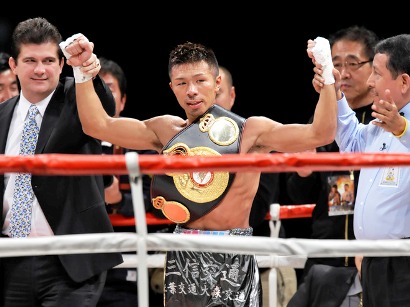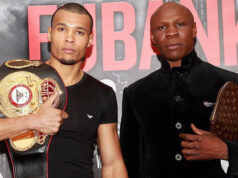Japan is and has long been a force in the ranks of international championship boxing, mostly at the professional level, but increasingly at the amateur level. In the midst of a boxing boom, the number of Japanese champions and contenders in the sport is mind-boggling. And when looking at some of the best up-and-coming pros, many of them are Japanese and on the brink of doing big things. Pound for pound, it’s difficult to find a country more productive in boxing than Japan. Let’s see how it breaks down across some different lines of analysis:
Today’s Pro Fighters
Japan has long had a stronghold on the lower weight divisions. There have been the odd Japanese welterweights or middleweights, but most of the good work out of Japanese fighters has occurred at 130 and below. As we look at it now, the lower-division weight classes are littered with Japanese titleholders and contenders. Most encouraging are the droves of rising prospects, some of them of the blue-chip variety.
In addition to Uchiyama, Yamanaka, and Kameda, there is Naoya Inoue, who won a 105-pound belt in his 6th fight and looks to be a young phenom. There is Kazuto Ioka, Akira Yaegashi, Kohei Kono, Tomoki Kameda, and Takashi Miura, among others. Between all these fighters, it’s safe to say Japan is in control when it comes to 130 pounds and below, with a slew of top fighters perched atop their respective weight classes.
Points: 4/5
Fans & Venues
Unlike here in the states, a good fighter in Japan is a star. It’s not the most popular sport in the country, but it occupies a high standing in Japanese society. There are some serious hardcore fans in Japan. It is a sport-crazy nation, with baseball, golf, racing, and especially sumo getting a lot of attention. And though boxing is big, there are other forms of martial arts that also attract a lot of fan attention. Fans are very proud of their most successful boxers.
Korakuen Hall is one of the world’s legendary boxing venues, having hosted dozens upon dozens of the more important Japanese boxing matches over the years. In addition, there are countless other venues, some sprawling arenas, where boxing is held. The cards, on all levels, are generally well-attended. Japan is pretty self-reliant in the area of boxing, hence the plethora of arenas in most regions of Japan.
Points: 4/5
Amateur system
For years, the Japanese amateur system toiled at the international level. After 3 medal winners in the 60’s, there was as 44-year medal drought, but the 2012 Olympics in London offered a lot of hope, with Japan bringing home two medals, with Satoshi Shimizu winning bronze and middleweight Ryota Murata taking home the gold. Murata is looking to break through at a higher division than Japanese are accustomed and is a great prospect. In light of recent success, look for increased success from the competitive Japanese amateur system.
Points: 4/5
Professional system
It’s sort of like team sports in Japan, where boxers are all required to be part of a gym, with fighters in that same gym unable to fight each other. To change a gym would be like changing teams in a team sport here, with it being somewhat difficult.
It’s fair to say Japanese boxing is somewhat insulated, especially from the west. It’s a system that works within itself. They make more money, presumably, by running the whole show with TV considerations than they would get by accepting a small piece of a bigger event in the USA. As a result, a lot of Japanese champions are not recognized outside of their homeland or maybe Asia. At the same time, the competition is not any less fierce, since the best fighters from these divisions happen to come from Japan and nearby nations.
There are some powerful gyms in Japan with top trainers who have led multiple fighters to world title glory. At the head of the group is Teiken Gym, which has been home to numerous world champions. It’s just that there are so many good fighters in Japan that many gyms feature some high-level training with experienced trainers with world title fight experience. It’s a rich boxing culture.
Points: 4/5
History & Significance
A self-sustaining industry with no help from the outside for almost a century, boxing has a undisputed slot high among the nation’s sports. Added success begets more attention. There are a slew of popular champions, the controversial Kameda brothers, and the added Olympic success that has Japan on the fringe of big things in the sport.
Again, Japan has been insulated from the world for the most part. That hasn’t stopped them from staking a claim in the pages of boxing history books. Fighting Harada is considered one of the greatest flyweights/bantamweights ever. Yoko Gushiken is considered one of the best 108-pounders of all time. Jiro Watanabe is one of the all-time greats at 115. Masao Ohba and Shoji Oguma were top flyweights, with Koichi Wajima making a strong imprint at 154 pounds. Most of these may not be divisions with a ton of western interest, but excellence is not necessarily contingent on American or European recognition.
The best boxers have high visibility in the country. Even here in the U.S., all but the absolute best-known world champions may have trouble getting recognized on a street corner. Ask any Japanese who the Kameda brothers are and they will know. Fans are aware of the history and know the top Japanese boxers of the past. Not a lot of countries are like that.
Points: 4/5
Number of ProBoxing-Fans.com Top 20 Pound for Pound
Japan has a healthy representation in the ProBoxing-Fans.com top-20, with 3 fighters among the ranked boxers. Among them are Takashi Uchiyama, ShinsukeYamanaka, and Koki Kameda. Yamanaka is considered by most to be the finest bantamweight in the world, with Uchiyama and Kameda among the best at 130 and 126, respectively. With three fighters in the top 20, with more on their way, Japan has a healthy amount of fighters at the top levels of the sport. 3 points for 3 guys in the top 20.
Bonus Points: 3
Overall Boxing World Cup Score for Japan: 23 points











